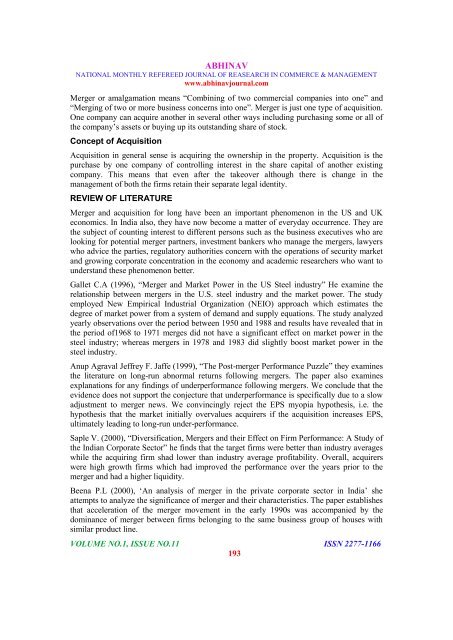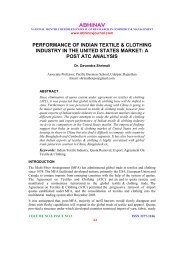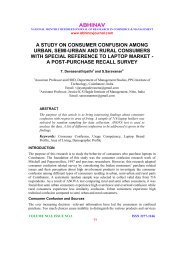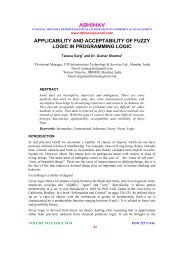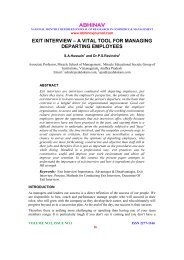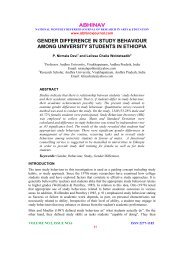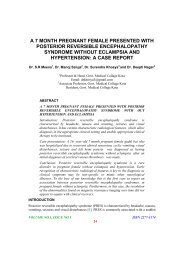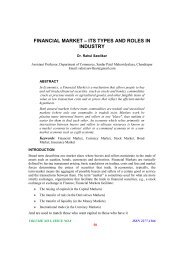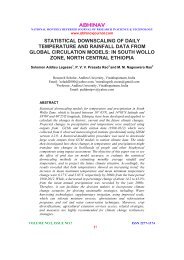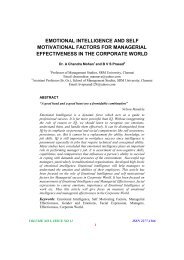A Study On Financial Performance Of Selected Companies During ...
A Study On Financial Performance Of Selected Companies During ...
A Study On Financial Performance Of Selected Companies During ...
Create successful ePaper yourself
Turn your PDF publications into a flip-book with our unique Google optimized e-Paper software.
ABHINAV<br />
NATIONAL MONTHLY REFEREED JOURNAL OF REASEARCH IN COMMERCE & MANAGEMENT<br />
www.abhinavjournal.com<br />
Merger or amalgamation means “Combining of two commercial companies into one” and<br />
“Merging of two or more business concerns into one”. Merger is just one type of acquisition.<br />
<strong>On</strong>e company can acquire another in several other ways including purchasing some or all of<br />
the company’s assets or buying up its outstanding share of stock.<br />
Concept of Acquisition<br />
Acquisition in general sense is acquiring the ownership in the property. Acquisition is the<br />
purchase by one company of controlling interest in the share capital of another existing<br />
company. This means that even after the takeover although there is change in the<br />
management of both the firms retain their separate legal identity.<br />
REVIEW OF LITERATURE<br />
Merger and acquisition for long have been an important phenomenon in the US and UK<br />
economics. In India also, they have now become a matter of everyday occurrence. They are<br />
the subject of counting interest to different persons such as the business executives who are<br />
looking for potential merger partners, investment bankers who manage the mergers, lawyers<br />
who advice the parties, regulatory authorities concern with the operations of security market<br />
and growing corporate concentration in the economy and academic researchers who want to<br />
understand these phenomenon better.<br />
Gallet C.A (1996), “Merger and Market Power in the US Steel industry” He examine the<br />
relationship between mergers in the U.S. steel industry and the market power. The study<br />
employed New Empirical Industrial Organization (NEIO) approach which estimates the<br />
degree of market power from a system of demand and supply equations. The study analyzed<br />
yearly observations over the period between 1950 and 1988 and results have revealed that in<br />
the period of1968 to 1971 merges did not have a significant effect on market power in the<br />
steel industry; whereas mergers in 1978 and 1983 did slightly boost market power in the<br />
steel industry.<br />
Anup Agraval Jeffrey F. Jaffe (1999), “The Post-merger <strong>Performance</strong> Puzzle” they examines<br />
the literature on long-run abnormal returns following mergers. The paper also examines<br />
explanations for any findings of underperformance following mergers. We conclude that the<br />
evidence does not support the conjecture that underperformance is specifically due to a slow<br />
adjustment to merger news. We convincingly reject the EPS myopia hypothesis, i.e. the<br />
hypothesis that the market initially overvalues acquirers if the acquisition increases EPS,<br />
ultimately leading to long-run under-performance.<br />
Saple V. (2000), “Diversification, Mergers and their Effect on Firm <strong>Performance</strong>: A <strong>Study</strong> of<br />
the Indian Corporate Sector” he finds that the target firms were better than industry averages<br />
while the acquiring firm shad lower than industry average profitability. Overall, acquirers<br />
were high growth firms which had improved the performance over the years prior to the<br />
merger and had a higher liquidity.<br />
Beena P.L (2000), ‘An analysis of merger in the private corporate sector in India’ she<br />
attempts to analyze the significance of merger and their characteristics. The paper establishes<br />
that acceleration of the merger movement in the early 1990s was accompanied by the<br />
dominance of merger between firms belonging to the same business group of houses with<br />
similar product line.<br />
VOLUME NO.1, ISSUE NO.11 ISSN 2277-1166<br />
193


